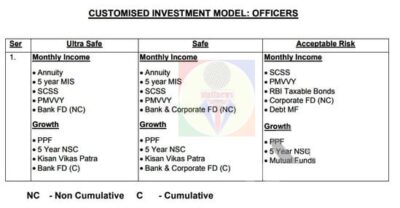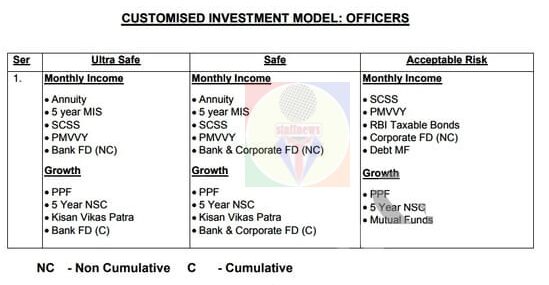Investment Model – Officers: Every year approximately 1200 officers retire from service
INVESTMENT MODEL : OFFICERS
1. Every year approximately 1200 officers retire from service. The transition into a peaceful and secure retired life entails safe and prudent investment decisions. The funds available on retirement are sufficient to supplement the pension and also to create a saving corpus which grows with time. It is thus imperative for officers to take informed investment decisions to cater for current and future goals ensuring safety of capital and sound returns.
2. Guidelines prepared to help this endeavour is in following parts :-
(a) Principles of Investment.
(b) Assets available for Investment.
(C) Recommendations for Investments.
(d) Miscellaneous.
PART I — PRINCIPLES OF INVESTMENT
3. A substantial amount becomes available to the retiree at the time of retiring form service. It is imperative that the retiree takes charge of the financial planning and deployment of the available funds at the earliest.
4. some of the principles of investment which should be kept in mind before investing are as under :-
(a) Safety. It is important that the investment is done keeping safety of amount invested. There should not be risk of losing the principal amount invested.
(b) Liquidity. Some portion of the money should be invested in a manner that it can be redeemed at short notice to cater for any emergency.
(c) Inflation. Inflation eats into the value of money. One should invest in financial products which have a rate of return higher than inflation.
(d) Loans. Avoid taking loans. Loans can be taken for buying a house but monthly EMI should be affordable.
5. Risk. At the outset, one must understand one’s own risk taking profile before investing. Risk taking profile implies the willingness and the ability of a person to take financial risks. For example, an officer retiring with commitments of settling children in terms of professional education and marriage will have little or no room for taking on risks. Generally, higher risk investments have the potential to give higher returns but can also result in negative returns. Before investing, one must find out the risk of that investment so that it aligns with your risk taking profile.
6. Tax. It is essential that Tax planning is dovetailed into the Investment plan. The taxes can be reduced by investing in such instruments which are covered under section 80C of the Income Tax Act.
7. Before investing in a particular product, do check for the following :-
(a) Does this product fit into my risk profile?
(b) Is this achieving any goal for me?
(c) What is the cost involved in buying and holding the product?
(d) What is the likely return potential? Is it fixed or variable? Is there likelihood of loss of capital?
(e) Does the product have a lock-in period? If yes, is it acceptable to you?
(f) What is the taxation on the product?
PART II — ASSETS AVAILABLE FOR INVESTMENT
8. The money needs to be invested in a manner that it generates additional monthly income as also caters for financial goals such as children education, marriage, purchase of house etc.
9. The assets available for generating monthly income are as under :-
(a) Post Office Monthly Income Scheme.
(b) senior Citizens Savings Scheme.
(c) PM Vaya Vandana Yojna.
(d) Bank Fixed Deposits.
(e) RBI Taxable Bonds.
(f) Corporate Fixed Deposits.
(g) Debt Mutual Funds.
10. The assets available for generating growth of available corpus for goals which are some time away are as under :-
(a) Mutual Funds.
(b) National Savings Certificate.
(c) Kisan Vikas Patra.
(e) Bank Fixed Deposits.
(f) Sovereign Gold Bond.
11. More details of the above schemes have been given at Appendix ‘A’.
12. Mutual Funds. Mutual Funds are a category of investment which can be used for both growth and monthly income requirements. Mutual funds invest in the equity market and the debt market in the country. One should invest in Mutual Funds only if one fully understands the product or if the same is recommended by a Financial Advisor. Mutual Funds carry the risk of loss of capital with the potential of giving higher returns. One can invest a lump sum amount or periodically through Systematic Investment Plan. Mutual Funds under the Equity Linked Savings Scheme (ELSS) category are eligible for Section 80C deduction for tax.
13. Gold. Gold is an important investment asset in our society. Keeping physical Gold in house is very risky from safety point of view. It is recommended that investments in Gold should be done through Sovereign Gold Bonds issued by the Government.
14. Avoiding Fraud. It is important that the officers do not lose money due to fraud. The officers are likely to get incorrect advice by people with vested interests due to the large amount available, hence caution needs to be exercised in following aspects :-
(a) Do not invest in Chit funds.
(b) Do not give Power of Attorney to anyone.
(c) Be wary of fraud calls.
(d) Be wary of people who promise extremely high returns. These are generally without any guarantee and are unsecured.
(e) Do not give loan to relatives/ local persons.
15. Tax. Investments eligible under Section 80 C and other relevant Sections of the Income Tax Act are given in a separate table at Appendix ‘B’.
PART III— RECOMMENDATIONS FOR INVESTMENT
16. These recommendations are broad recommendations. Each individual case may be different. These recommendations will act as a good start point before finalising one’s investments.
17. Three options have been given for executing the investment plan. These are Ultra Safe, Safe and Acceptable Risk. Ultra Safe model is for those who do not want to take any risk and do not have basic understanding about financial products. Safe model is for those who have basic knowledge about financial products and want their money to grow safely. Acceptable Risk is for those who have adequate knowledge about financial products and can take decisions based on their risk taking capacity.
18. Customised Investment Model. Investment options available have been tabulated to enable the officers to make a considered choice based on their risk taking ability. This list is not exhaustive. Officers can choose other products if they meet their requirements. Details of the same are given in Appendix ‘C’.
PART IV — MISCELLANEOUS
19. The officer has to be sensible in utilising the money in a safe manner. It is likely that the officer would need to get in touch with someone for financial advice. It will have to be a person whom he/she can trust and who will give financial advice without any vested interest.
20. Selecting a Financial Advisor. A financial advisor is a person who is a registered individual with SEBI and has the requisite qualifications towards guidance in investments based on requirements. These are generally available in major towns across India. The officers must preferably use the services of a Financial Advisor, if available. It is advisable to get a Financial Plan made through a SEBI registered investment advisor which caters to specific requirements. List of some advisers is available at https://www.sebi.gov.in/sebiweb/other/OtherAction.do?doRecognisedFpi=yes&intmId=13
21. It is important to balance between money required on a monthly basis with investing money for requirements at an older age.
22. Saving for Children Education. The Officers must invest money required for their children education in a manner that the investment matures when they have to go for their higher studies.
CONCLUSION
23. It is imperative that the officers carry out due diligence in the course of taking investment decisions. With safety of capital attaining primacy, it is important to take prudent and informed decisions so as to ensure decent returns and capital growth beating inflation. Sound investment decisions and periodic review of the same would thus be the harbinger towards a contended and comfortable retired life.

Source: Click here to read further

COMMENTS